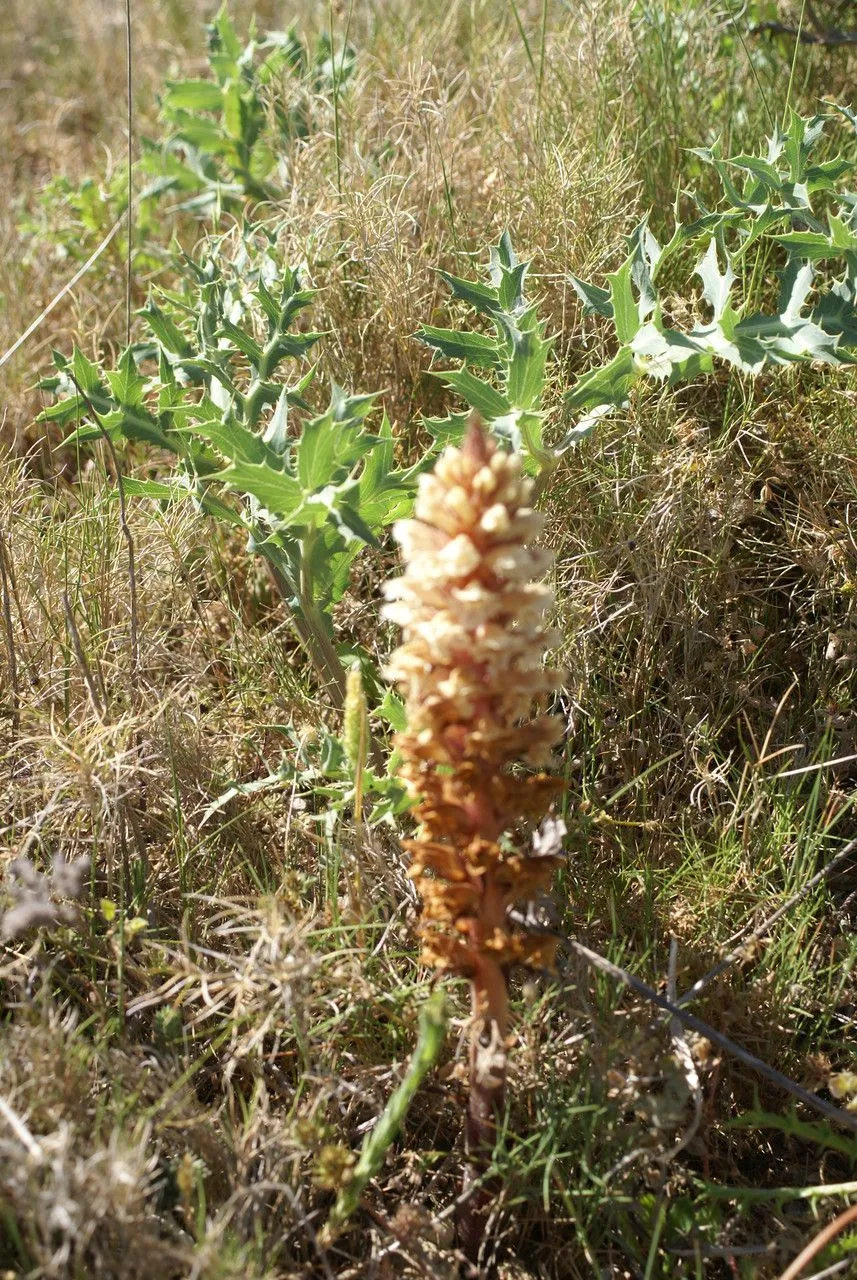
Author: Thuill.
Bibliography: Fl. Env. Paris, ed. 2: 317 (1799)
Year: 1799
Status: accepted
Rank: species
Genus: Orobanche
Vegetable: False
Observations: Canary Is., W. Europe to W. & C. Medit., Türkiye to N. Pakistan
The Amethyst Broomrape, scientifically known as Orobanche amethystea, is a fascinating member of the Orobanchaceae family. This plant was first documented in the second edition of “Florae Parisiensis” in 1799 by the author Thuill.
Orobanche amethystea thrives in several diverse habitats ranging from the Canary Islands and Western Europe to the Western and Central Mediterranean regions. Its distribution extends further to Türkiye and reaches as far as Northern Pakistan. This wide geographical spread indicates the plant’s adaptability to various environmental conditions.
The Amethyst Broomrape is a parasitic plant, typically found attached to the roots of other plants from which it derives its nutrients. Like its relatives within the Orobanchaceae family, it lacks chlorophyll and does not perform photosynthesis. Instead, it relies on a complex relationship with its host plants for survival.
Morphologically, the Amethyst Broomrape can be identified by its distinctive amethyst-hued flowers, which contribute to its common name. These vibrant blooms make it a unique and attractive plant despite its parasitic nature. It’s often observed in areas with rich floral diversity, further adding to the ecological tapestry of those regions.
Given its parasitic lifestyle, Orobanche amethystea plays a specific role in its ecosystems. While it can pose a threat to some host plants, it also forms part of a complex web of biological interactions that illustrate the intricacies of plant life.
Studying the Amethyst Broomrape can provide deeper insights into parasitic plant mechanisms, co-evolution with host species, and the broader ecological dynamics within its habitats. It serves as a remarkable example of nature’s adaptability and the intricate connections between species in diverse ecosystems.
Deu: amethyst-sommerwurz
Eng: amethyst broomrape
Nld: violette bremraap
Swe: ametistsnyltrot, violett snyltrot
En: Amethyst broomrape, Sea-holly Broomrape
Nl: Violette bremraap
Fi: Piikkiputkennäive
Fr: Orobanche couleur d’améthyste, Orobanche du panicaut, Orobanche violette
De: Amethyst-Sommerwurz, Amethystblaue Sommerwurz, Amethystblaue-Sommerwurz
It: Succiamele ametistino
Sv: Ametistsnyltrot, Violett snyltrot
Taken May 17, 2022 by geo noble (cc-by-sa)
Taken May 15, 2017 by Tela Botanica − Liliane ROUBAUDI (cc-by-sa)
Taken May 17, 2022 by Nicole oriege (cc-by-sa)
Taken Jun 16, 2016 by Tela Botanica − Alain BIGOU (cc-by-sa)
Taken May 29, 2016 by Amedeo Alberto Falci (cc-by-sa)
Taken May 19, 2019 by marteddu alain (cc-by-sa)
Taken May 8, 2022 by Josep Manuel Álvarez de la Campa Fayos (cc-by-sa)
Taken Apr 30, 2022 by Joelle Lebihan (cc-by-sa)
Taken Jun 19, 2020 by Markus Burger (cc-by-sa)
Taken May 15, 2017 by Tela Botanica − Liliane ROUBAUDI (cc-by-sa)
© copyright of the Board of Trustees of the Royal Botanic Gardens, Kew.
© copyright of the Board of Trustees of the Royal Botanic Gardens, Kew.
© copyright of the Board of Trustees of the Royal Botanic Gardens, Kew.
Taken May 15, 2017 by Tela Botanica − Liliane ROUBAUDI (cc-by-sa)
Taken May 18, 2013 by Tela Botanica − Genevieve BOTTI (cc-by-sa)
Taken May 18, 2013 by Tela Botanica − Genevieve BOTTI (cc-by-sa)
Taken May 22, 2013 by Tela Botanica − Frédéric MéLIER (cc-by-sa)
Taken May 18, 2013 by Tela Botanica − Genevieve BOTTI (cc-by-sa)
Taken Aug 26, 2022 by Caw Vus (cc-by-sa)
Taken Jul 13, 2021 by Pierre LEON (cc-by-sa)
Taken Apr 29, 2020 by leo (cc-by-sa)
Taken Jun 10, 2016 by Tela Botanica − Alain BIGOU (cc-by-sa)
Taken Jun 16, 2016 by Tela Botanica − Alain BIGOU (cc-by-sa)
Taken Apr 15, 2006 by Photoflora – Benoit BOCK (©)
Taken May 15, 2006 by Photoflora – Benoit BOCK (©)
Taken Aug 15, 2018 by Photoflora – Corine OOSTERLEE (©)
Taken Jan 1, 1970 by Photoflora – L’Abbé COSTE (©)
Taken Aug 15, 2010 by Photoflora – Benoit BOCK (©)
Taken Aug 15, 2006 by Photoflora – Bernard TILLY (©)
Taken Apr 15, 2006 by Photoflora – Benoit BOCK (©)
Taken May 15, 2012 by Photoflora – Benoit BOCK (©)
Taken Apr 15, 2006 by Photoflora – Benoit BOCK (©)
Taken May 23, 2006 by Tela Botanica − Mathieu MENAND (cc-by-sa)
Ph maximum: 8.0
Ph minimum: 7.5
Light: 8
Atmospheric humidity: 3
Soil nutriments: 4
Family: Myrtaceae Author: (F.Muell.) K.D.Hill & L.A.S.Johnson Bibliography: Telopea 6: 402 (1995) Year: 1995 Status:…
Family: Rubiaceae Author: Pierre ex A.Froehner Bibliography: Notizbl. Bot. Gart. Berlin-Dahlem 1: 237 (1897) Year:…
Family: Sapindaceae Author: Koidz. Bibliography: J. Coll. Sci. Imp. Univ. Tokyo 32(1): 38 (1911) Year:…
Family: Asteraceae Author: A.Gray Bibliography: Pacif. Railr. Rep.: 107 (1857) Year: 1857 Status: accepted Rank:…
Family: Fabaceae Author: Medik. Bibliography: Vorles. Churpfälz. Phys.-Ökon. Ges. 2: 398 (1787) Year: 1787 Status:…
Family: Aspleniaceae Author: (Cav.) Alston Bibliography: Bull. Misc. Inform. Kew 1932: 309 (1932) Year: 1932…